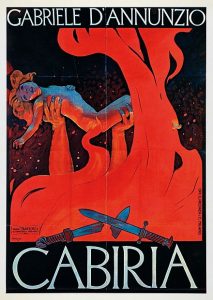Chen Xingtong on Cabiria (1915)
The story of Cabiria took place at the Punic Wars in the third century BCE which was divided into several episodes, The first episode showed at first, it was peaceful and happy to see a routine life of a huge noble Roman family while a disaster came suddenly and plunged them into terror. Then Croessa and Cabiria came out to be sold in the marketplace of Carthage, saved as she ws about to be sacrificed to Moloch. Maciste—a muscular African slave who, on behalf of his Roman commander, rescues the incarcerated heroine in enemy territory.As the film goes on, the epic aspects increase – battles are fought, kings are captured, armies surrender, towns are sacked.
The film ends on a triumphant note, affirming Rome’s supremacy over the all the people of the world,which came on the heels of Italy’s victory in the Libyan War of 1911-12, and it was one of many epics produced just prior to World War I.

Maciste, with his strength, vitality, and virility,and the kindness and goodness of his character,who was chained for years to a grindstone, breaks his chains, is imprisoned, forces apart the prison bars, hurls his enemies to their deaths,embodied the nation and the national spirit that pervaded Italy in the first half of the twentieth century. Maciste proved himself more than just physically fit. He came to serve as a paragon of the strongman’s metamorphosis from icon of ancient glories of the classical film epics, so popular in the early years of Italian cinema, to exemplary symbol of modern Italian heroism.
As for character, Maciste’s role in the narrative is central and crosses various emotional and dramatic registers. Many of his scenes are quite humorous, particularly when he and Fulvio axilla become inebriated as they take refuge in a wine cellar. Maciste also has moments of tenderness on screen; for instance, in one scene he plays with the young cabiria on his lap and tends to her in an almost maternal fashion. Attraction and narration work well together when the scenes expressed about the characteristics of Maciste and the story.There are no true closeups in “Cabiria,” although there are medium and medium-long shots. The typical shot stands back far enough to incorporate a great deal of architecture along.The lack of close-ups gives us a hard time to feel strongly for the characters or even give them the characteristic symbols we are so used of today. It also is extremely story-based and rely heavily on inter-titles.

It should be admitted that new technology revolutionizes behavior, transforms the cultural landscape, sets significant mutations in motion and makes it possible to let people dissolve in the plot and to pass cinema on to a new cultural, artistic and media order. The cinema at that time is completely offered a fully immersive experience for the audience, especially in elaborately staged battle scenes, a stunning desert-crossing sequence, play with natural light. They hide characters in the shadows while others are fully illuminated. We watch the sun fade over the desert and the slow motion of people across it. And the plot features strategic appearances by the Roman military leader. In addition to its elaborate set design and groundbreaking moving camera, Cabiria’s other technical innovations included strategic use of artificial lighting, ornate costume design, and a complexity in plot previously unseen in Italian cinema. Scenes of the eruption of Mount etna, the human sacrifice at the Temple of Moloch, and Hannibal crossing the alps reveal the unique range of special effects and inventive use of color that the film achieved.
It is noted that the musical accompaniment featured a live orchestra playing an original score in this film but versatile solo piano on the soundtrack after. In so-called early cinema era, not only was early cinema, as a rule, unaccompanied by recorded sounds; in addition, its viewers were not always seated in straight rows or subject to a strict code of silence. So it had been improved a lot compared with the early cinema, and in particular, the premieres and showings of Cabiria around italy, and later around the world, were major and unique events, highly promoted and publicized by Itala with elaborately designed posters, brochures, and programs. in Rome, for instance, the noted pilot Giovanni Widmer distributed foyers from the air on the day of the film’s premiere.

Yet in its particular way, “Cabiria” is beautiful and enthralling. In his novel The Book of Illusions, Paul Austerhas a remarkable passage about the appeal of silent films:
“They were like poems, like the renderings of dreams, like some intricate choreography of the spirit, and because they were dead, they probably spoke more deeply to us now than they had to the audiences of their time. We watched them across a great chasm of forgetfulness, and the very things that separated them from us were in fact what made them so arresting: their muteness, their absence of color, their fitful, speeded-up rhythms.”

